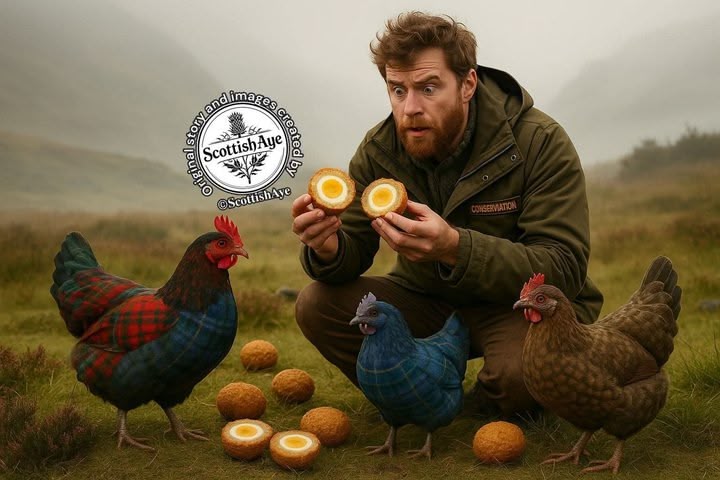The Tart Hen and the Legend of the Scotch Egg
SCOTLAND’S MOST MYSTERIOUS BIRD UNCOVERED: The Tart Hen and the Legend of the Scotch Egg
Long before the clans of Scotland marched into battle wearing their famous kilts, before tartan was stitched into fashion lore, and long before Kelty Fried Chicken got their hands on a deep fat fryer… there existed a bird so bonnie, so braw, and so biologically baffling, it changed the course of culinary and textile history forever, The Tart Hen.
Native only to the glens and crags of Alba, this elusive feathered marvel boasts a natural tartan pattern unique to its region. Each breed’s plumage became the inspiration for the local clan tartans, a gift from nature that helped early Scots identify family, territory, and who to throw a caber at on sight. Scientists now believe the hens’ complex feather patterns developed as an evolutionary trait, not just for camouflage, but as a sophisticated form of tribal signalling. In a sense, tartan wasn’t just a result of evolution, it was the evolution. Over time, the name Tart Hen slurred and morphed into Tartan, now used to describe the iconic Scottish patterns that all began on the feathery backside of a mildly aggressive bird.
Across Scotland, the Tart Hen’s plumage adapted uniquely to its local environment. In the Highlands, hens developed striking patterns of red and green, colours later mirrored in the region’s now famous clan tartans. On the western isles, coastal breeds displayed windswept streaks of blue and grey, providing inspiration for the island weaves still worn at weddings and celebrations to this day. Lowland hens, ever more reserved, evolved with muted earth tones and tight, fussily neat striping, a natural precursor to the understated tartans of the southern clans. Each bird’s feathers served as a living mood board for Scotland’s entire fashion identity.
But while their patterning was iconic, it’s their reproductive miracle that truly sets the Tart Hen apart.
The Scotch Egg.
Unlike any other bird, the Tart Hen lays a fully encased, breadcrumb coated, meat armoured egg. No shell. No yolky mess. Just a perfectly formed sphere of protein and pride. At its core lies a firm, no nonsense egg, always hard boiled by the time it leaves the hen, no boiling water required. Surrounding the egg is a dense, protein rich outer layer, a naturally evolved meat casing that functions like biological armour, not unlike the protective sacs found in certain amphibians or insects. The final breadcrumb like crust is the result of the Tart Hen’s notoriously high carb diet, consisting largely of barley, oats, and the occasional chip shop sweeping. This unique nutritional profile alters the makeup of its egg laying fluids, which react with airborne particles to form a crisp, golden coating the moment the egg hits open air.
Today, the Scotch egg is a national treasure, enjoyed at weddings, stag dos, ceilidhs, and any moment vaguely resembling a celebration. And though the Tart Hen remains a rare sight, conservationists are doing their best to keep the species thriving by ensuring optimal calcium and protein intake through tailored diets that mimic ancestral foraging behaviours. With every perfectly laid egg, the Tart Hen continues to embody Scotland’s greatest values, resilience, style, and the evolutionary elegance of encasing nutrition in protective protein.
Long before the clans of Scotland marched into battle wearing their famous kilts, before tartan was stitched into fashion lore, and long before Kelty Fried Chicken got their hands on a deep fat fryer… there existed a bird so bonnie, so braw, and so biologically baffling, it changed the course of culinary and textile history forever, The Tart Hen.
Native only to the glens and crags of Alba, this elusive feathered marvel boasts a natural tartan pattern unique to its region. Each breed’s plumage became the inspiration for the local clan tartans, a gift from nature that helped early Scots identify family, territory, and who to throw a caber at on sight. Scientists now believe the hens’ complex feather patterns developed as an evolutionary trait, not just for camouflage, but as a sophisticated form of tribal signalling. In a sense, tartan wasn’t just a result of evolution, it was the evolution. Over time, the name Tart Hen slurred and morphed into Tartan, now used to describe the iconic Scottish patterns that all began on the feathery backside of a mildly aggressive bird.
Across Scotland, the Tart Hen’s plumage adapted uniquely to its local environment. In the Highlands, hens developed striking patterns of red and green, colours later mirrored in the region’s now famous clan tartans. On the western isles, coastal breeds displayed windswept streaks of blue and grey, providing inspiration for the island weaves still worn at weddings and celebrations to this day. Lowland hens, ever more reserved, evolved with muted earth tones and tight, fussily neat striping, a natural precursor to the understated tartans of the southern clans. Each bird’s feathers served as a living mood board for Scotland’s entire fashion identity.
But while their patterning was iconic, it’s their reproductive miracle that truly sets the Tart Hen apart.
The Scotch Egg.
Unlike any other bird, the Tart Hen lays a fully encased, breadcrumb coated, meat armoured egg. No shell. No yolky mess. Just a perfectly formed sphere of protein and pride. At its core lies a firm, no nonsense egg, always hard boiled by the time it leaves the hen, no boiling water required. Surrounding the egg is a dense, protein rich outer layer, a naturally evolved meat casing that functions like biological armour, not unlike the protective sacs found in certain amphibians or insects. The final breadcrumb like crust is the result of the Tart Hen’s notoriously high carb diet, consisting largely of barley, oats, and the occasional chip shop sweeping. This unique nutritional profile alters the makeup of its egg laying fluids, which react with airborne particles to form a crisp, golden coating the moment the egg hits open air.
Today, the Scotch egg is a national treasure, enjoyed at weddings, stag dos, ceilidhs, and any moment vaguely resembling a celebration. And though the Tart Hen remains a rare sight, conservationists are doing their best to keep the species thriving by ensuring optimal calcium and protein intake through tailored diets that mimic ancestral foraging behaviours. With every perfectly laid egg, the Tart Hen continues to embody Scotland’s greatest values, resilience, style, and the evolutionary elegance of encasing nutrition in protective protein.






